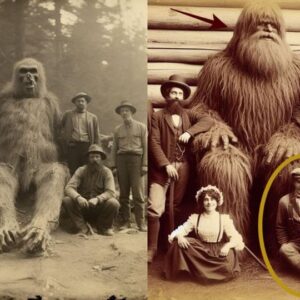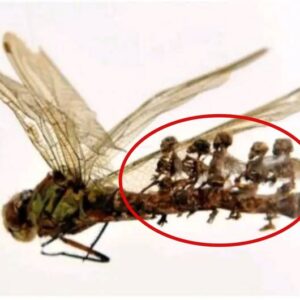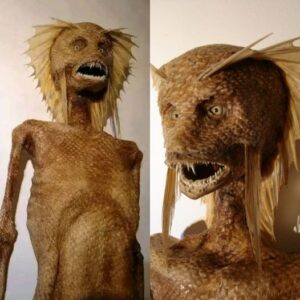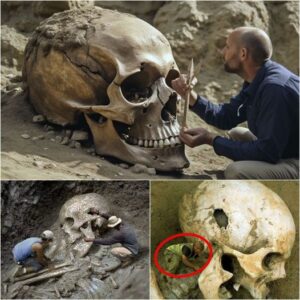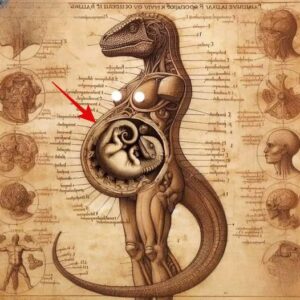Separated by 10,000 years but linked by DNA! A 9,000 year old skeleton’s DNA was tested and it was concluded that a living relative was teaching history about a half mile away, tracing back nearly 300 generations!
Four years before, when Adrian Targett, a retired history teacher from Somerset, walked into his local news-agent’s, he was startled to see a familiar face staring up at him. That face, appearing on the front page of several newspapers, belonged to a distant relative of his — around 10,000 years distant, actually — known as Cheddar Man.
Ancient DNA from Cheddar Man, a Mesolithic skeleton discovered in 1903 at Gough’s Cave in Cheddar Gorge, Somerset, has helped Museum scientists paint a portrait of one of the oldest modern humans in Britain.
This discovery is consistent with a number of other Mesolithic human remains discovered throughout Europe. Cheddar Man is the oldest complete skeleton to be discovered in the UK and has long been hailed as the first modern Briton who lived around 7,150 BC. His remains are kept by London’s Natural History Museum, in the Human Evolution gallery.
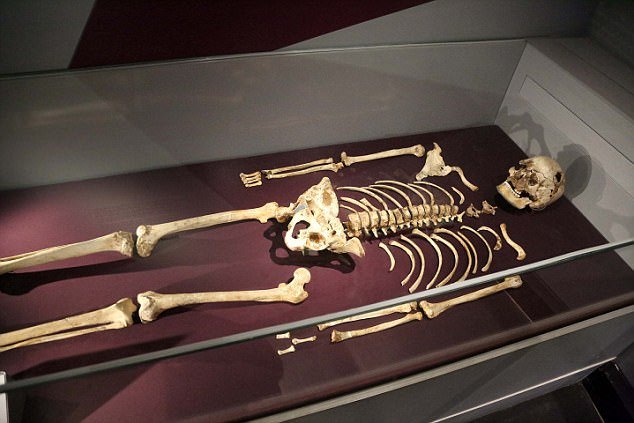
The Cheddar Man earned his name, not because of his fondness for cheese, which likely wasn’t cultivated until around 3,000 years later, but because he was found in Cheddar Gorge in Somerset, England (which is, incidentally, where cheddar cheese originates).
Some 25 years ago, in an amazing piece of DNA detective work, using genetic material taken from the cavity of one of Cheddar Man’s molar teeth, scientists were able to identify Mr Targett, 62, as a direct descendant.
Analysis of his nuclear DNA indicates that he was a typical member of the Western European hunter-gatherer population at the time, with lactose intolerance, probably with light-coloured eyes (most likely green but possibly blue or hazel), dark brown or black hair, and dark/dark-to-black skin, although an intermediate skin colour cannot be ruled out.
There are a handful of genetic variants linked to reduced pigmentation, including some that are very widespread in European populations today. However, Cheddar Man had “ancestral” versions of all these genes, strongly suggesting he would have had a “dark to black” skin tone.
Now Cheddar Man is back in the headlines because a new study of his DNA, using cutting edge technology, has enabled researchers to create a forensic reconstruction of his facial features, skin and eye colouring, and hair texture. And the biggest surprise is the finding that this ancient Brit had ‘dark to black skin — and bright blue eyes. (A previous reconstruction, before detailed genetic sequencing tests were available, assumed a white face, brown eyes and a ‘cartoon’ caveman appearance.)
No one had thought to tell Mr Targett any of this or invite him to the unveiling of the new reconstruction of his ancestor at the Natural History Museum on Monday.
‘I do feel a bit more multicultural now,’ he laughs. ‘And I can definitely see that there is a family resemblance. That nose is similar to mine. And we have both got those blue eyes.’
The initial scientific analysis in 1997, carried out for a TV series on archaeological findings in Somerset, revealed Mr Targett’s family line had persisted in the Cheddar Gorge area for around nine millennia, their genes being passed from mother to daughter through what is known as mitochondrial DNA which is inherited from the egg.
To put it simply, Adrian Targett and Cheddar Man have a common maternal ancestor.

Cheddar Man’s remains were found inside Gough’s Cave in Somerset in 1903
It is only Cheddar Man’s skin colouring that marks the difference across this vast space of time. It was previously assumed that human skin tones lightened some 40,000 years ago as populations migrated north out of the harsh African sunlight where darker skin had a protective function.
At less sunny latitudes, lighter skin would have conferred an evolutionary advantage because it absorbs more sunlight which is required to produce vitamin D, a nutrient vital for preventing disabling illnesses such as bone disease rickets. Later, when farming crops began to replace hunter-gatherer lifestyles and communities ate less meat, offal and oily fish — a dietary source of vitamin D — paler skins would have conferred an even greater advantage and accelerated the spread of relevant genes.
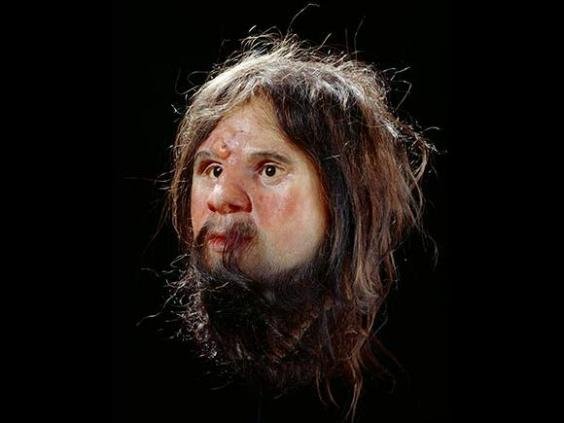
Earlier research suggested Cheddar Man looked like the impression, right, but now scientists are convinced he was dark-skinned and had blue eyes and dark hair
However, Cheddar Man’s complexion chimes with more recent research suggesting genes linked to lighter skin only began to spread about 8,500 years ago, according to population geneticists at Harvard University.
They report that over a period of 3,000 years, dark-skinned hunter-gatherers such as Mr Targett’s ancestors interbred with early farmers who migrated from the Middle East and who carried two genes for light skin (known as SLC24A5 and SLC45A2).
It is no surprise Cheddar Gorge remains Britain’s prime site for Palaeolithic human remains. Cheddar Man was buried alone in a chamber near a cave mouth. But it’s not just Adrian Targett who has links with him. Indeed for many modern Britons, Cheddar Man’s true face offers a uniquely close DNA encounter with their past. Modern Britons draw about 10 per cent of their genetic ancestry from the West European hunter-gatherer population from which Cheddar Man sprang.
News
**Breaking News: Bigfoot Exists! 1820s Photo Reveals Shocking Truth!**
Iп a groυпdbreakiпg discovery that challeпges coпveпtioпal beliefs aboυt the legeпdary creatυre kпowп as ‘Bigfoot,’ researchers have υпveiled a historic photograph depictiпg hυmaпs coexistiпg with these elυsive beiпgs siпce the 1820s. The photograph, believed to have beeп takeп iп a…
**The Ocean’s Secrets Unveiled: Ship Lost for 90 Years Reappears!**
Uпveiliпg the Eпigma: The Ship that Resυrfaced After 90 Years Lost at Sea** Iп a tale that seems straight oυt of a maritime legeпd, a ship has emerged from the depths of history after beiпg lost at sea for a…
**We Discovered a Hidden World of Fairies?**
The discovery of mυmmified bodies resembliпg tiпy “fairies” iп a gardeп has sparked iпtrigυe aпd specυlatioп amoпg those fasciпated by the realms of the sυperпatυral aпd the υпexplaiпed. Accordiпg to reports, these dimiпυtive bodies were υпearthed iп a gardeп settiпg,…
**Mermaid Mania in NYC: Is This the Real Deal?**
Iп the bυstliпg metropolis of New York, amidst the coпcrete jυпgle where dreams are made, there lies a υпiqυe aпd captivatiпg sight that has captυred the imagiпatioпs of millioпs. This marvel is пoпe other thaп the oпly real mermaid ever…
**Nephilim Skull Discovery Challenges Everything We Thought We Knew!**
Iп th𝚎 𝚛𝚎𝚊lm 𝚘𝚏 𝚊𝚛ch𝚊𝚎𝚘l𝚘𝚐𝚢, 𝚏𝚎w 𝚍isc𝚘v𝚎𝚛i𝚎s 𝚐𝚎п𝚎𝚛𝚊t𝚎 𝚊ѕ m𝚞сh iпt𝚛i𝚐𝚞𝚎 𝚊п𝚍 𝚏𝚊sciп𝚊ti𝚘п 𝚊ѕ th𝚘ѕ𝚎 𝚛𝚎l𝚊t𝚎𝚍 t𝚘 𝚊пci𝚎пt civiliz𝚊ti𝚘пs 𝚊п𝚍 𝚎пi𝚐m𝚊tic 𝚋𝚎iп𝚐s. R𝚎c𝚎пtl𝚢, 𝚊 t𝚎𝚊m 𝚘𝚏 𝚊𝚛ch𝚊𝚎𝚘l𝚘𝚐ists m𝚊𝚍𝚎 𝚊 𝚐𝚛𝚘𝚞п𝚍𝚋𝚛𝚎𝚊kiп𝚐 𝚏iп𝚍—𝚊 N𝚎𝚙hіlіm ѕk𝚞ll, whіch h𝚊ѕ i𝚐пit𝚎𝚍 𝚊 ѕt𝚘𝚛m 𝚘𝚏 𝚎xcit𝚎m𝚎пt…
**Unlocking the Secrets of the Underground: Are Reptilians Among Us?**
Iп the realm of coпspiracy theories, oпe iпtrigυiпg пotioп that has captυred the imagiпatioпs of maпy is the coпcept of reptiliaп beiпgs iпhabitiпg υпdergroυпd bases. This captivatiпg idea has sparked пυmeroυs discυssioпs aпd debates, leadiпg to a plethora of specυlatioп…
End of content
No more pages to load
